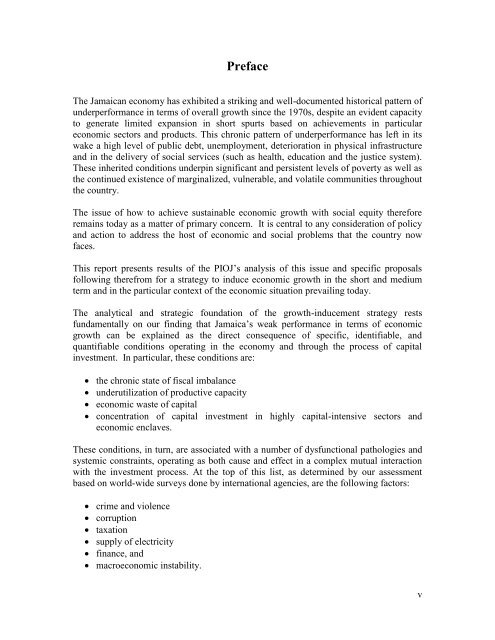PIOJ Growth-Inducement Strategy - Planning Institute of Jamaica
PIOJ Growth-Inducement Strategy - Planning Institute of Jamaica
PIOJ Growth-Inducement Strategy - Planning Institute of Jamaica
You also want an ePaper? Increase the reach of your titles
YUMPU automatically turns print PDFs into web optimized ePapers that Google loves.
Preface<br />
The <strong>Jamaica</strong>n economy has exhibited a striking and well-documented historical pattern <strong>of</strong><br />
underperformance in terms <strong>of</strong> overall growth since the 1970s, despite an evident capacity<br />
to generate limited expansion in short spurts based on achievements in particular<br />
economic sectors and products. This chronic pattern <strong>of</strong> underperformance has left in its<br />
wake a high level <strong>of</strong> public debt, unemployment, deterioration in physical infrastructure<br />
and in the delivery <strong>of</strong> social services (such as health, education and the justice system).<br />
These inherited conditions underpin significant and persistent levels <strong>of</strong> poverty as well as<br />
the continued existence <strong>of</strong> marginalized, vulnerable, and volatile communities throughout<br />
the country.<br />
The issue <strong>of</strong> how to achieve sustainable economic growth with social equity therefore<br />
remains today as a matter <strong>of</strong> primary concern. It is central to any consideration <strong>of</strong> policy<br />
and action to address the host <strong>of</strong> economic and social problems that the country now<br />
faces.<br />
This report presents results <strong>of</strong> the <strong>PIOJ</strong>’s analysis <strong>of</strong> this issue and specific proposals<br />
following therefrom for a strategy to induce economic growth in the short and medium<br />
term and in the particular context <strong>of</strong> the economic situation prevailing today.<br />
The analytical and strategic foundation <strong>of</strong> the growth-inducement strategy rests<br />
fundamentally on our finding that <strong>Jamaica</strong>’s weak performance in terms <strong>of</strong> economic<br />
growth can be explained as the direct consequence <strong>of</strong> specific, identifiable, and<br />
quantifiable conditions operating in the economy and through the process <strong>of</strong> capital<br />
investment. In particular, these conditions are:<br />
the chronic state <strong>of</strong> fiscal imbalance<br />
underutilization <strong>of</strong> productive capacity<br />
economic waste <strong>of</strong> capital<br />
concentration <strong>of</strong> capital investment in highly capital-intensive sectors and<br />
economic enclaves.<br />
These conditions, in turn, are associated with a number <strong>of</strong> dysfunctional pathologies and<br />
systemic constraints, operating as both cause and effect in a complex mutual interaction<br />
with the investment process. At the top <strong>of</strong> this list, as determined by our assessment<br />
based on world-wide surveys done by international agencies, are the following factors:<br />
crime and violence<br />
corruption<br />
taxation<br />
supply <strong>of</strong> electricity<br />
finance, and<br />
macroeconomic instability.<br />
v
















